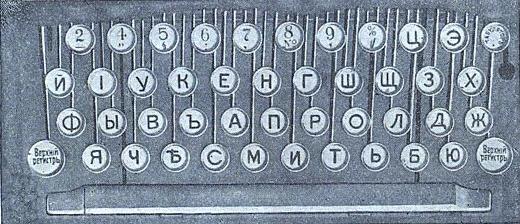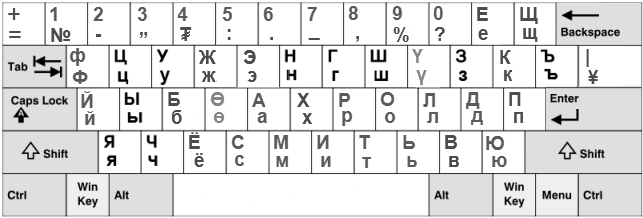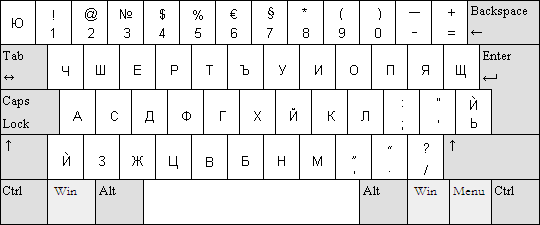JCUKEN on:
[Wikipedia]
[Google]
[Amazon]
JCUKEN (''ЙЦУКЕН'', also known as ''YCUKEN'', ''YTsUKEN'' and ''JTSUKEN'') is the main
















 ''Phonetic Cyrillic keyboard layout for Bulgarian in 2006 (Also known as "ЧШЕРТЪ" ChShert).''
''Phonetic Cyrillic keyboard layout for Bulgarian in 2006 (Also known as "ЧШЕРТЪ" ChShert).''


Cyrillic
The Cyrillic script ( ), Slavonic script or the Slavic script, is a writing system used for various languages across Eurasia. It is the designated national script in various Slavic, Turkic, Mongolic, Uralic, Caucasian and Iranic-speaking co ...
keyboard layout
A keyboard layout is any specific physical, visual or functional arrangement of the keys, legends, or key-meaning associations (respectively) of a computer keyboard, mobile phone, or other computer-controlled typographic keyboard.
is the actua ...
for the Russian language
Russian (russian: русский язык, russkij jazyk, link=no, ) is an East Slavic language mainly spoken in Russia. It is the native language of the Russians, and belongs to the Indo-European language family. It is one of four living E ...
in computer
A computer is a machine that can be programmed to carry out sequences of arithmetic or logical operations ( computation) automatically. Modern digital electronic computers can perform generic sets of operations known as programs. These prog ...
s and typewriter
A typewriter is a mechanical or electromechanical machine for typing characters. Typically, a typewriter has an array of keys, and each one causes a different single character to be produced on paper by striking an inked ribbon selectivel ...
s. Earlier in Russia
Russia (, , ), or the Russian Federation, is a transcontinental country spanning Eastern Europe and Northern Asia. It is the largest country in the world, with its internationally recognised territory covering , and encompassing one-ei ...
''JIUKEN'' (''ЙІУКЕН'') layout was the main layout, but it was replaced by JCUKEN when the Russian alphabet reform of 1917 removed the letters Ѣ, І, Ѵ, and Ѳ. The letter Ъ had decreased in usage significantly after the reform.
Alternative layouts include the Russian phonetic keyboard layouts, in which Cyrillic letters correspond to similar-sounding Latin letters in QWERTY
QWERTY () is a keyboard layout for Latin-script alphabets. The name comes from the order of the first six keys on the top left letter row of the keyboard ( ). The QWERTY design is based on a layout created for the Sholes and Glidden ty ...
and other layouts.
JCUKEN
PC
Typewriters
Used on typewriters before personal computers. It is available inMicrosoft Windows
Windows is a group of several proprietary graphical operating system families developed and marketed by Microsoft. Each family caters to a certain sector of the computing industry. For example, Windows NT for consumers, Windows Server for ...
as a legacy layout.
JIUKEN
The JIUKEN layout was used before the Russian spelling reform of 1918. It includes the Cyrillic dotted or "decimal" I as well asyat
Yat or jat (Ѣ ѣ; italics: ) is the thirty-second letter of the old Cyrillic alphabet and the Rusyn alphabet.
There is also another version of yat, the iotified yat (majuscule: , minuscule: ), which is a Cyrillic character combining ...
, which were eliminated after the reform, but it does not include the letters fita
Fita (Ѳ ѳ; italics: ) is a letter of the Early Cyrillic alphabet. The shape and the name of the letter are derived from the Greek letter theta (Θ θ). In the ISO 9 system, Ѳ is romanized using F grave accent (F̀ f̀).
In the ...
and izhitsa, which were rare even before the reform. The numbers 1, 3 and 0 do not appear on the layout and were replaced with the decimal I, Ze, and O respectively. The letters Ц and Э are located side-by-side, and between the Che
Che, Ché, Chè or CHE may refer to:
People
* Ché Ahn, (born 1956), American Christian pastor
* Che Guevara (1928–1967), Argentine Marxist revolutionary
* Che (surname) (车), Chinese surname
* Che Lovelace (born 1969), Trinidadian artist
Ar ...
and the Es is the yat
Yat or jat (Ѣ ѣ; italics: ) is the thirty-second letter of the old Cyrillic alphabet and the Rusyn alphabet.
There is also another version of yat, the iotified yat (majuscule: , minuscule: ), which is a Cyrillic character combining ...
. The letter yo is not included in this layout.
Other languages
JCUKEN is the basis for many other Cyrillic layouts. For the current momentMicrosoft Windows
Windows is a group of several proprietary graphical operating system families developed and marketed by Microsoft. Each family caters to a certain sector of the computing industry. For example, Windows NT for consumers, Windows Server for ...
supports the following layouts: Azerbaijani
Azerbaijani may refer to:
* Something of, or related to Azerbaijan
* Azerbaijanis
* Azerbaijani language
See also
* Azerbaijan (disambiguation)
* Azeri (disambiguation)
* Azerbaijani cuisine
* Culture of Azerbaijan
The culture of Azerbaijan ...
(Cyrillic), Bashkir, Belarusian, Kazakh, Kyrgyz Kyrgyz, Kirghiz or Kyrgyzstani may refer to:
* Someone or something related to Kyrgyzstan
*Kyrgyz people
*Kyrgyz national games
*Kyrgyz language
*Kyrgyz culture
*Kyrgyz cuisine
*Yenisei Kirghiz
*The Fuyü Gïrgïs language in Northeastern China
...
, Mongolian, Tajik, Ukrainian
Ukrainian may refer to:
* Something of, from, or related to Ukraine
* Something relating to Ukrainians, an East Slavic people from Eastern Europe
* Something relating to demographics of Ukraine in terms of demography and population of Ukraine
* So ...
, Uzbek (Cyrillic), Yakut (Sakha). The Belarusian, Ukrainian and Mongolian layouts have been available since Windows 95
Windows 95 is a consumer-oriented operating system developed by Microsoft as part of its Windows 9x family of operating systems. The first operating system in the 9x family, it is the successor to Windows 3.1x, and was released to manufacturi ...
; Azeri, Kazakh, Kyrgyz, Tatar, Uzbek since Windows XP
Windows XP is a major release of Microsoft's Windows NT operating system. It was release to manufacturing, released to manufacturing on August 24, 2001, and later to retail on October 25, 2001. It is a direct upgrade to its predecessors, Wind ...
; Bashkir and Tajik since Windows Vista
Windows Vista is a major release of the Windows NT operating system developed by Microsoft. It was the direct successor to Windows XP, which was released five years before, at the time being the longest time span between successive releases of ...
; Yakut since Windows 7
Windows 7 is a major release of the Windows NT operating system developed by Microsoft. It was Software release life cycle#Release to manufacturing (RTM), released to manufacturing on July 22, 2009, and became generally available on October 22, ...
.
Other operating systems such as Linux
Linux ( or ) is a family of open-source Unix-like operating systems based on the Linux kernel, an operating system kernel first released on September 17, 1991, by Linus Torvalds. Linux is typically packaged as a Linux distribution, whi ...
may have their own additional custom layouts for the same or other languages.
Belarusian
Theshort U
Short U (Ў ў; italics: ) is a letter of the Cyrillic script. The only Slavic language using this letter in its orthography is Belarusian, though it is used as a phonetic symbol in some Russian and Ukrainian dictionaries. Among the non-Sl ...
(Ў ў) is located in place of the shcha
Shcha (Щ щ; italics: ), Shta or Sha with descender is a letter of the Cyrillic script. In Russian, it represents the voiceless alveolo-palatal fricative , similar to the pronunciation of in ''sheep'' (but longer). In Ukrainian and Rusy ...
(Щ щ). It is the only JCUKEN keyboard that lacks a key for И, as it is the only language in the Cyrillic script that does not contain the letter И itself; the decimal I (І і) replaces it. It also lacks a hard sign (Ъ ъ), usually seen just to the right of letter ha (Х х) as that position is taken by the Apostrophe.
Ukrainian
The decimal I replaces the yeru (Ы ы) and theyest
Ukrainian Ye (Є є; italics: ) is a character of the Cyrillic script. It is a separate letter in the Ukrainian alphabet (8th position since 1992, 7th position before then), the Pannonian Rusyn alphabet, and both the Carpathian Rusyn alp ...
(Є є) replaces the E (Э э). The letter Yi (Ї ї) substitutes for the hard sign (Ъ ъ), and Ghe with upturn
Ghe with upturn (Ґ ґ; italics: ) is a letter of the Cyrillic script. It is part of the Ukrainian alphabet, the Pannonian Rusyn alphabet and both the Carpathian Rusyn alphabets, and also some variants of the Urum and Belarusian (i.e. Be ...
(Ґ ґ) is also used.
Tatar
The Russian letters which are rarely used in Tatar are typed with (right ). This layout is also suitable for Kalmyk and Turkmen (Cyrillic) as their alphabets are practically identical to Tatar. It is called as YÖUKEN.Bashkir
Kazakh
Kyrgyz
An "upgraded" version based on the basic Russian one, the additional Kyrgyz letters are typed with (right ). Thus, + У is Ү, + О is Ө, and + Н is Ң.Yakut (Sakha)
Tajik
This is a modified version of JCUKEN called YQUKEN, in which the Ka with descender (Қ қ) substitutes the C (Ц ц). The yeru (Ы ы) is replaced by the letter Che with descender (Ҷ ч). Also, the soft sign (Ь ь) is replaced by the I with macron (Ӣ ӣ). Further, the Kha with descender (Ҳ ҳ), the U with macron (Ӯ ӯ), and theghayn
The Arabic letter ( ar, غَيْنْ ' or ') is the nineteenth letter of the Arabic alphabet, one of the six letters not in the twenty-two akin to the Phoenician alphabet (the others being , , , , ), it represents the sound or . In name and ...
(Ғ ғ) are used. (In Unicode, Kha with descender is known as "Ha with descender".)
Uzbek
Theshort U
Short U (Ў ў; italics: ) is a letter of the Cyrillic script. The only Slavic language using this letter in its orthography is Belarusian, though it is used as a phonetic symbol in some Russian and Ukrainian dictionaries. Among the non-Sl ...
substitutes the shcha
Shcha (Щ щ; italics: ), Shta or Sha with descender is a letter of the Cyrillic script. In Russian, it represents the voiceless alveolo-palatal fricative , similar to the pronunciation of in ''sheep'' (but longer). In Ukrainian and Rusy ...
, like the Belarusian keyboard (see above), and the ka with descender substitutes the yery
Yeru or Eru (Ы ы; italics: ), usually called Y in modern Russian or Yery or Ery historically and in modern Church Slavonic, is a letter in the Cyrillic script. It represents the close central unrounded vowel (more rear or upper than i) ...
. Moreover, the letter ghayn
The Arabic letter ( ar, غَيْنْ ' or ') is the nineteenth letter of the Arabic alphabet, one of the six letters not in the twenty-two akin to the Phoenician alphabet (the others being , , , , ), it represents the sound or . In name and ...
substitutes the minus sign
The plus and minus signs, and , are mathematical symbols used to represent the notions of positive and negative, respectively. In addition, represents the operation of addition, which results in a sum, while represents subtraction, resul ...
and the underscore
An underscore, ; also called an underline, low line, or low dash; is a line drawn under a segment of text. In proofreading, underscoring is a convention that says "set this text in italic type", traditionally used on manuscript or typescript ...
, while the kha with descender substitutes the plus sign
The plus and minus signs, and , are mathematical symbols used to represent the notions of positive and negative, respectively. In addition, represents the operation of addition, which results in a sum, while represents subtraction, res ...
and equal sign.
Azerbaijani
This layout is a modified version called the JÜUKEN, and includes the Che with vertical stroke,shha
Shha or He (Һ һ; italics: ) is a letter of the Cyrillic script. Its form is derived from the Latin letter H (H h ), but the capital forms are more similar to a rotated Cyrillic letter Che (Ч ч) or a stroke-less Tshe (Ћ ћ) be ...
, Ka with vertical stroke, and the Je. It is the only JCUKEN without the usual Й, as the language lacks the glyph, which was replaced by Je in 1958.
Substitutions to this keyboard are: having the schwa
In linguistics, specifically phonetics and phonology, schwa (, rarely or ; sometimes spelled shwa) is a vowel sound denoted by the IPA symbol , placed in the central position of the vowel chart. In English and some other languages, it rep ...
replacing the ya, the oe replacing the yu, the ghayn
The Arabic letter ( ar, غَيْنْ ' or ') is the nineteenth letter of the Arabic alphabet, one of the six letters not in the twenty-two akin to the Phoenician alphabet (the others being , , , , ), it represents the sound or . In name and ...
replacing the soft sign, the Che with vertical stroke replacing the hard sign, the ue replacing the tsa
The Transportation Security Administration (TSA) is an agency of the United States Department of Homeland Security (DHS) that has authority over the security of transportation systems within, and connecting to the United States. It was created ...
and the shha
Shha or He (Һ һ; italics: ) is a letter of the Cyrillic script. Its form is derived from the Latin letter H (H h ), but the capital forms are more similar to a rotated Cyrillic letter Che (Ч ч) or a stroke-less Tshe (Ћ ћ) be ...
replacing the shcha
Shcha (Щ щ; italics: ), Shta or Sha with descender is a letter of the Cyrillic script. In Russian, it represents the voiceless alveolo-palatal fricative , similar to the pronunciation of in ''sheep'' (but longer). In Ukrainian and Rusy ...
.
Mongolian
The Mongolian keyboard uses a modified version of JCUKEN, called FCUZHEN (ФЦУЖЭН), where letters specific to Russian are replaced by letters that see more use in Mongolian.
Other Cyrillic layouts
Serbian
The Serbian keyboard called LJNJERTZ (ЉЊЕРТЗ), where letters of Serbian language was used instead of Russian letters. It lacks the yers and yeru (Ъ ъ, Ь ь and Ы ы), Э, and Ё. It is based on the QWERTZ keyboard.
Macedonian
Also utilizing a modification of the Serb-style LJNJERTZ (LJNJERTDZ), a single "dead key" is used for input for Macedonian letters Gje «Ѓ ѓ» and Kje «Ќ ќ», as well as the typewritten apostrophe (in combination with the «spacebar»): «м. к. á», «К к» → «Ќ ќ», «м. к. á», «space» → «'». Macedonian keyboard layouts under Microsoft Windows (KBDMAC.DLL and KBDMACST.DLL) do not use "dead keys". Instead, letters Gje and Kje are present as dedicated keys, and AltGr is used to access additional letters and punctuation.Bulgarian
''Standard Bulgarian keyboard from 2006 (YUEIShSht)'' ''Phonetic Cyrillic keyboard layout for Bulgarian in 2006 (Also known as "ЧШЕРТЪ" ChShert).''
''Phonetic Cyrillic keyboard layout for Bulgarian in 2006 (Also known as "ЧШЕРТЪ" ChShert).''

Latin JCUKEN
This was the predominant layout on the Soviet-mademicrocomputer
A microcomputer is a small, relatively inexpensive computer having a central processing unit (CPU) made out of a microprocessor. The computer also includes memory and input/output (I/O) circuitry together mounted on a printed circuit board (PC ...
s during the 1980s - the Cyrillic characters on most keys being supplemented with their Latin equivalents, and punctuation filling gaps where no direct Latin equivalent exists.
See also
*QWERTY
QWERTY () is a keyboard layout for Latin-script alphabets. The name comes from the order of the first six keys on the top left letter row of the keyboard ( ). The QWERTY design is based on a layout created for the Sholes and Glidden ty ...
References